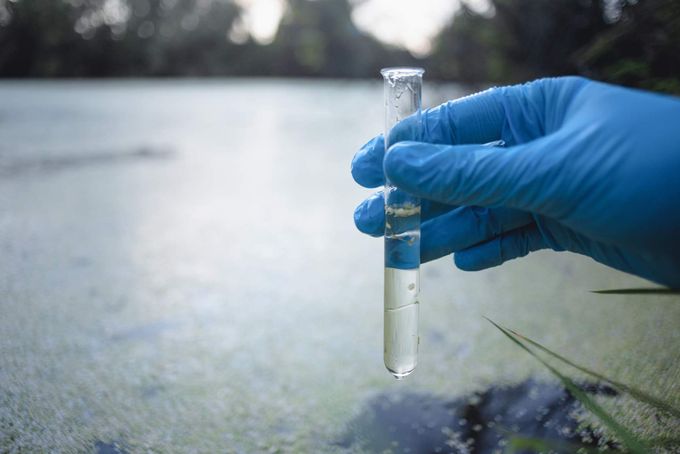Why storm overflows exist

Rainwater enters the same system that takes our wastewater to treatment plants, overloading this combined sewer network during storms (credit: iStock/Chunyip Wong)
Storm overflows are structures located in the sewer network, or at wastewater treatment plants, that discharge excess rainwater and wastewater – usually untreated – via outfall pipes directly into rivers or coastal waters.
They serve as a safety valve when the sewer network is at risk of being overwhelmed. This typically happens during heavy rainfall, when high volumes of water are entering the system over a short period, or when sewer blockages occur.
They are a legacy of a system that lets surface water runoff from roofs, roads and hard standings enter the same network that handles wastewater, which is why they are also called combined sewer overflows. They exist to prevent the mixture from backing up into people’s homes.
There are 15,000 storm overflows in England, 13,350 of which empty into inland rivers, according to a 2021 research report prepared by Stantec for Water UK, the trade body representing the nation’s water and wastewater companies.
How a storm overflow works
Source: Water UK
As the UK population grows and the density of housing increases, more and more permeable surfaces are being paved over. This factor, along with changing rainfall patterns and the growing ingress of groundwater into the ageing network, means that ever more water is entering the combined sewer system. This, in turn, is resulting in huge numbers of spills from outfall pipes.
In 2022 alone, there were more than 300,000 recorded spills in England, 83,000 in Wales and 14,000 in Scotland. There is growing public concern that all these discharges are causing excessive ecological damage in the affected rivers and coastal waters.
What happens when there’s a spill

There are 15,000 storm overflows in England, almost 90% of which empty into inland rivers (credit: iStock/Konoplytska)
Stantec’s research for Water UK notes that, while storm overflow spills are normally diluted compared with wastewater, they are untreated. This means that contaminants and pathogens can enter the natural environment, resulting in:
- Harm to river health. Water quality can be worsened by intermittently low levels of dissolved oxygen and high levels of ammonia. Other pollutants include microplastics, pharmaceuticals, heavy metals, bacteria and excessive nutrients, as well as visible sewer litter.
- Harm to public health. Spills can render bathing or other recreational uses of the affected waters unsafe, because they increase the risk of bacterial infection.
- Social impacts. Growing public awareness of the high number of overflow spills is prompting widespread concern about environmental health and the proper operation of wastewater infrastructure.
How the harms can be reduced

While storm overflow spills are normally diluted compared with wastewater, they are untreated (credit: iStock/HappyNati)
The government has instructed water companies to reduce both the frequency and volume of storm overflow spills. The first step in achieving this is to understand all of the causes.
Although most spills occur during periods of heavy rainfall, there are also dry spills, which – as their name suggests – happen when no rain has fallen.
For instance, having analysed data collected by monitors at its outfalls, Southern Water has attributed about a quarter of spills from its network to damaged pipes, which are letting groundwater into the system. The firm has started an extensive maintenance and repair programme to address this problem.
Dry spills can also be attributed to misconnections in private pipework and equipment failures at wastewater treatment plants, or to sewer blockages caused by the accumulation of non- biodegradable solids such as wet wipes.
Where heavy rainfall is the cause, a range of engineering solutions could be applied to reduce the volume and frequency of storm overflow discharges, or at least limit the harm they cause:
- Split the combined sewer system into independent foul water and surface water networks. The report for Water UK estimates that the creation of separate wastewater and stormwater systems in England would be a highly complex and disruptive project costing at least £350bn.
- Add storage capacity to the system or make better use of its existing capacity. Extra capacity can be created by building or enlarging storage tanks, although this may be costly and carbon-intensive. Other options include optimising existing capacity by reconfiguring treatment plants and using smart digital technology to manage the network so that runoff is diverted to pipes or treatment plants offering the most spare storage at any given time.
- Manage storm runoff to keep it out of the combined sewer. Nature-based solutions can be used both to store excess surface water until capacity in the network becomes available and to enable stormwater to infiltrate the ground. Household measures include rain gardens, water butts to collect roof runoff and permeable paving. Similar solutions, including slow-drain planters and detention basins, can be installed at factories, warehouses and large public buildings such as hospitals and schools. Highway runoff can be collected in roadside swales and verge rain gardens.
- Treat discharges from overflows to remove pollutants. If a spill is unavoidable, there is still scope to make that water cleaner. Potential treatments include chemical or ultraviolet disinfection or nature-based solutions such as constructed wetlands or reed beds, which can significantly reduce the amount of suspended solids and other pollutants entering rivers and seas. Wetlands offer extra potential benefits, including flood reduction and public amenity, but they require a lot of space to be available near the outfall.
Some combination of these approaches may be required, depending on the location and wastewater catchment. But prioritising quick wins – by optimising storage capacity, remedying misconnections and installing cheap and simple solutions such as water butts, for instance – might reduce the need to adopt costlier sustainable drainage systems or build more carbon-intensive grey infrastructure.
Other factors contributing to poor river health
In certain catchments, factors other than storm overflow discharges are having a bigger negative impact on the water quality of UK rivers. They include:
- Contaminated runoff from agricultural land
- Contaminated runoff from roads entering rivers via highway drains and surface water sewers
- Final effluent from the wastewater treatment process
- Illegal connections of wastewater into surface water sewers
Because of this, policies focused solely on minimising storm overflow spills may not achieve the desired improvements in river health.
But, as the report for Water UK notes, policies designed to improve wider river quality outcomes are not as popular with the public. This is because discharges from outflow pipes are often highly visible to people, who tend to associate them with pollution, even though long-term monitoring might prove that the impact of such spills on river health is not significant.
To tackle the wider problem of poor water quality and river health requires input from several agencies, organisations, landowners and the public at catchment-wide level.
Sign up to receive news from ICE Knowledge direct to your inbox.







